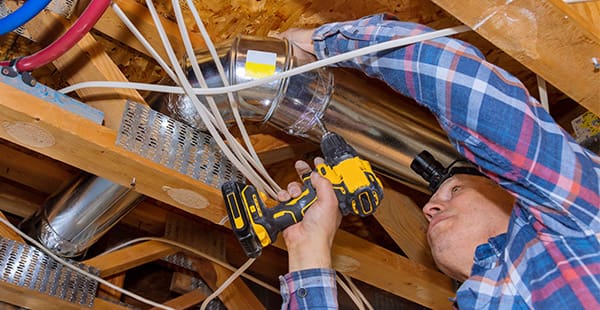Why Was Asbestos Used in Ductwork Connectors?
Older ductwork connectors and heating, ventilation and air conditioning (HVAC) systems often have asbestos for various reasons. Asbestos in air duct components helped these systems withstand heat and hold the metal ducts together. Asbestos-wrapped ducts also helped reduce vibrations and noise caused by the airflow through ducting. Asbestos was often used in these connectors for its fire resistance and durability.
The use of asbestos ductwork started in the early 1900s. One asbestos inspection documented use of asbestos ductwork in a home built in 1927. Heating ducts continued using asbestos connectors until the 1980s when regulations started to take effect.
Asbestos Ductwork Connectors History at a Glance
- Other Names: Canvas duct connectors, duct adhesive, duct blankets, duct dampeners, duct sealer, duct tape, duct wrap, ductwork tape, fabric duct connector, flexible duct connectors, paper duct insulation, tape duct connector, vinyl or rubber-coated connectors
- Years of Manufacture: Early 1900s – 1980s
- Places Used: HVAC systems
- Asbestos Use Banned: Chrysotile asbestos was banned for new uses in 2024, but some old ductwork connectors may still contain asbestos
- Noteworthy Brands: Celotex Corporation, Duro Dyne Corporation, H.B. Fuller, Johns-Manville
Ducts run throughout buildings and homes to move heated or cooled air to different rooms. HVAC systems contained asbestos in many different components and duct materials.
Many older homes, buildings and schools may have HVAC systems constructed with asbestos parts. If the asbestos duct connectors become damaged, they can spread the asbestos through the air. As a result, anyone who lives or works in these buildings may be at risk of exposure.
Asbestos exposure causes mesothelioma, asbestosis, lung cancer and other diseases.
List of Asbestos Ductwork Connectors
Manufacturers produced different types of ductwork connectors and other HVAC system components. Companies often wove asbestos into fabrics and tape used to seal the ducts. The mineral made these products more durable, heat resistant and flexible.
Starting at least by the 1930s, companies sold asbestos-containing HVAC flexible duct connectors and sealers. For example, Duro Dyne Corporation produced duct connectors and duct sealers that contained chrysotile asbestos fibers. Some of its ductwork connectors known to contain asbestos include:
- Duro Dyne Duct Sealer
- Duro-Metal-Fab Flexible Duct Connectors
- Econ-O-Fab Flexible Duct Connectors
- Junior Flexible Duct Connectors
Other companies also produced asbestos ductwork materials and HVAC components. Companies like Celotex Corporation and H.B. Fuller used asbestos in their HVAC duct connectors and sealers. For instance, Celotex Carey Duct Adhesive was known to contain asbestos from 1940 to 1955. Some other examples of asbestos duct products include:
- Celotex Carey Asbestos Insulating Ducts
- Celotex Carey Duct Adhesive
- Celotex Carey Insulation Duct
- H.B. Fuller Duct Sealer 32-04
Various manufacturers produced asbestos ductwork connectors. Some of these companies also made other asbestos products for duct systems. Asbestos ductwork tape and asbestos ductwork wrap were also popular.
Manufacturers that used asbestos in their products put factory workers at risk of exposure. HVAC workers, homeowners and others also risked exposure to friable asbestos.
Who Is at Risk of Asbestos Exposure From Ductwork Connectors?
Many people may be at risk of asbestos exposure from duct connectors and HVAC systems. But HVAC workers have a high risk of occupational exposure because they often work directly with the materials. HVAC workers risk exposure from other building materials, such as ceiling tiles, popcorn ceilings and insulation.
The risk HVAC workers face extends to homeowners. For example, any asbestos duct connector may become worn or damaged. This can lead to people inhaling or ingesting asbestos fibers.
Workers and homeowners should be cautious of these materials. For homeowners, licensed asbestos professionals should perform a thorough examination of older HVAC systems. HVAC workers should follow guidelines and safety protocols for handling asbestos.
Asbestos Lawsuits, Settlements & Other Compensation
Anyone exposed to asbestos ductwork connectors risks developing mesothelioma. Those diagnosed may be eligible for compensation through lawsuits or other claims. An attorney can help victims understand their options.
For instance, victims may be eligible to file asbestos lawsuits against the manufacturers whose products caused their exposures.
Individuals may also be eligible for other claims, such as an asbestos trust fund claim. An experienced asbestos attorney can help victims diagnosed with mesothelioma and other asbestos-related diseases. These attorneys have access to product information and can help gather details needed for the case. They can also explain victims’ legal options and handle the filing process.
Financial compensation can help mesothelioma victims and their loved ones. This compensation can cover treatment expenses, lost income and other related costs.
Safely Removing Asbestos Ductwork Connectors
Only a trained asbestos abatement professional should remove asbestos ductwork connectors. This is important because these materials pose exposure risks when handled. For example, asbestos tape and flexible duct connectors can easily release asbestos dust into the air when damaged or worn. Asbestos professionals have the experience and equipment to handle asbestos safely.
When working on HVAC systems, abatement professionals should shut off and isolate the system first. Isolating the HVAC system seals the ducts and vents. This keeps asbestos fibers from circulating during remediation.
Government agencies have asbestos regulations to help protect these professionals, other workers and the public from exposure.
The EPA suggests caution when cleaning air ducts. Asbestos in air ducts can happen when duct connections use contaminated components. Before cleaning, the EPA recommends having a professional inspection of the HVAC system for asbestos-containing materials. If testing finds asbestos, an abatement team can resolve the contamination.






